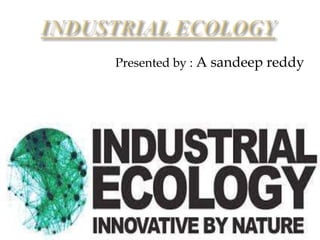Environment industrial ecology
The document discusses the concept of industrial ecology, which proposes that industrial systems should mimic natural ecosystems by having the wastes of one industry serve as resources for another. It was first introduced in 1973 as a way to minimize energy and material usage and reduce environmental impact. The key aspects of industrial ecology in practice include input-output analysis, by-product exchange between co-located industries, and taking a systems-level approach. The document also discusses recycling and its benefits, such as conserving natural resources and generating jobs, as well as some of the environmental costs of recycling processes. Overall, the document promotes minimizing waste and adopting a more circular economy approach across industries.

Recomendados
Recomendados
Mais conteúdo relacionado
Mais procurados
Mais procurados (20)
Semelhante a Environment industrial ecology
Semelhante a Environment industrial ecology (20)
Mais de MOULA HUSSAIN KHATTHEWALE
Mais de MOULA HUSSAIN KHATTHEWALE (12)
Último
Último (20)
Environment industrial ecology
- 1. Presented by : A sandeep reddy
- 2. •The term “Industrial Ecology” was first introduced by Harry Zvi Evan at a seminar of the Economic Commission of Europe in 1973.
- 3. Where did the idea “Industrial Ecology”, come from? • "why would not our industrial system behave like an ecosystem, where the wastes of a species may be resource to another species? • Why would not the outputs of an industry be the inputs of another, thus reducing use of raw materials, pollution, and saving on waste treatment?”
- 4. Industrial Ecology Approach to managing human activity on a sustainable basis by. • essential integration of human systems into natural systems. • Minimizing energy and materials usage. • Minimizing the ecological impact of human activity to levels natural systems can sustain.
- 6. Some of the systemic problems •Dealing with regulated waste is a direct cost to the business. • Un-regulated waste is an indirect cost to your employees, your customers, and you. • At best, waste is an inefficiency, a missed opportunity. • On a planet, resources are finite if not replenished via cycles.
- 7. Systemic Benefits •Does not externalize costs to society, your employees, you or your family • Increased efficiency •Increases innovation in yours and other’s businesses • May give rise to new product lines or services • Reduces costs • Increases revenues
- 8. Industrial Ecology in Practice Input - Output analysis at the systems level By-product exchange and energy cascading Physical connections between production units – close proximity of industry on one site Systems approach outside an Industrial estate No management and formal research involved
- 10. •RECYCLING •Is when you put things like glass,plastic,paper/cardboard into different coloured bins to be turned into something new example. Cardboard can be turned into a new cereal box. •Recycling saves land, reduces the amount of solid waste, energy consumption and pollution.
- 11. Problems, •Recycling does have environmental costs. •It uses energy and generates pollution. •Ex. the de-inking process in paper recycling requires energy, and produces a toxic sludge that contains heavy metals.
- 12. Benefits, •Conserves our natural resources •Has a positive effect on the economy by generating jobs and revenues. •For example, the Sunday edition of the New York Times consumes 62,000 trees. •Currently, only about 20% of all paper in North America is recycled
- 13. •Glass ! •Each family living in the UK uses 500 glass bottles and jars on average every year • Glass is 100% recyclable and can be used again and again • The largest glass furnace produces over 1million glass bottles and jars every day • Glass that is thrown away ends up in landfills and will never decompose (it will never rot away )
- 14. Paper and Cardboard •Recycled paper produces 73% less air pollution than other materials • 12.5 million tonnes of paper and cardboard are used annually in the UK • the average person in the UK goes through 38kg of newspapers every year • It takes 24 trees to make 1 ton of newspapers !
- 15. Plastic ! •2,75,000 tonnes of plastic is used each year in the UK that’s about 15 million bottles a day. • Most families throw away 40kg of plastic a year which could be recycled • plastic that ends up in landfills can take up to 500 years to decompose (rot) •The use of plastic in western Europe is going up by 4% every year
- 16. Many people underestimate Recycling •Tons of everyday items can be recycled, things like plastic, glass, aluminium and paper/cardboard are all things that we just throw away instead of recycling them. • Many people underestimate the benefits of recycling and how it would be better for the environment. • So before you throw away your rubbish that can be recycled just think
- 18. Solid wastes polluting a river in Jakarta, Indonesia. The man in the boat is looking for items to salvage or sell WASTING RESOURCES
